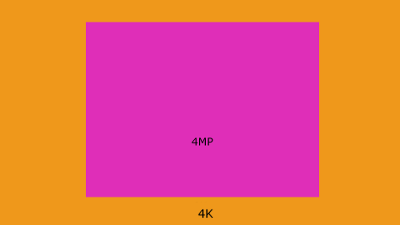When it comes to digital media, as in HD video, no 4MP is NOT the same as 4K. The difference can be explained by looking at a wonderful little element called a pixel. 4MP is less than 1080P, which is closer to 8MP.
 The pixel has multiplied like rabbits over the years. Maybe you remember as a kid sitting with your face against the TV(old CRT type) and seeing all those little blurry red, green and blue squares. You were staring at pixels.
The pixel has multiplied like rabbits over the years. Maybe you remember as a kid sitting with your face against the TV(old CRT type) and seeing all those little blurry red, green and blue squares. You were staring at pixels.
A Brief History of Resolution
The Advanced Television Systems Committee (ATSC) writes the international rules concerning digital broadcast signals. Earth bound electronic signals, cable television, and satellite television networks are beholden as a broadcaster, to these standards. The ATSC regulations were developed in the 1990s by a group made up of leading electronics and telecommunications companies.
The group goes by the name of The Grand Alliance, and they are the ones who have engineered today’s HDTV formats. Frame sizes such as 480i,720P, 1080P, 2K, 4K, 8K and so on where decided on by The Grand Alliance. This group is comprised of the worlds top electronic manufactures such as AT&T Corporation, Massachusetts Institute of Technology (MIT), Philips Consumer Electronics.
In 1993, the GA came out of the Federal Communications Commission (FCC) for specifically handling the regulations associated with broadcast data. Grand Alliance’s digital television (DTV) system is the foundation for the ATSC standards that are currently used today.
More Pixel Explanation
Let’s start with the idea of aspect ratios. In the days of square TVs, the aspect ratio of 4:3 was used. This represents for every 4 units across, there are 3 units up. Movies were slightly different as they would sometimes display “This movie has been altered from the original, It has been formatted to fit you television”.
So traveling down the technology road we come to the 16:9 aspect ratio, thanks in part to movies. This states 16 units across with 9 units up and this is the aspect ratio for HD like 720p, 1080P and now 4K, 8K and so on.
 As a side note, HD is identified from the vertical dimension… until you get to 4K, then it is the horizontal dimension of the screen that were talking about.
As a side note, HD is identified from the vertical dimension… until you get to 4K, then it is the horizontal dimension of the screen that were talking about.
How are 4MP and 4K different?
Is 4MP the same as 4K? 4MP and 4K are vastly different in the number of pixels and this means a big difference in the resolution we see on a standard TV screen.
When talking 2K, 4K or 8K, the suffix “k” means “thousand” and it refers to the horizontal dimension of the picture. There’s no mention of the word “pixel” as with the suffix “MP”. So a resolution of 4K needs to be multiplied by the vertical dimension to get an equivalent “MP” rating.
When talking 2MP, 4MP or 8MP it refers to the horizontal dimension multiplied by the vertical dimension. Kind of as if you were figuring out square footage for an area.
What is 4MP?
4MP stands for 4 Megapixels. There’s that word “pixel” again. Such an important little piece of the puzzle. Mega means “million”. So a 4MP resolution has nearly 4 million pixels to the image or screen size. That’s alot. Let’s look at some numbers to see the real world comparison.
4MP Frame Size
When dealing with HD, it is identified with the horizontal dimension such as 1080P. To get that many in a 16:9 format it means there are..
2240×1680 = 3,763,200
For comparison, Full HD 1920 x 1080 16:9 is known as 1080P, so 4MP is greater than a 1080 resolution by about 1,689,600 pixels.
Thank the regulators for making it not exactly 4 million. The pixel count in a bit shy of it’s name but it’s a rounding game at the end of the day.
What is 4K?
UHD 4K is the newest craze on store shelves when you travel down the TV isle and it’s a little funny because there really isn’t very much content to actually watch yet in 4K compared to little brother 1080P. Most programs and movies are still broadcast in 720P, 960H or the big dog of 1080P. There are also many more formats such as 1080i which can be found from time to time. See the article 1080P vs. 1080i for more info on 1080i.
So why the 4K buzz? Well it’s mostly marketing a new and better product. Each month there is more content to watch in true 4K but it’s a slow process. So it does has some value and it gets better and better all the time.
4K Frame Size
As mentioned earlier, 4K stands for 4 “thousand”. For 2K resolution, and 4K, and greater, we now are using this number as the horizontal pixel count, the opposite for 1080P and lower. 4K resolution has two types, and it’s not 4,000 pixels. I’m sorry but it’s just not. That would be very poor resolution by today’s standards. We call it 4K for simplicity. The first 4K is the ‘Cinema’ method. It’s distinction is 4K equals 4,096 pixels horizontal. We generally don’t use this for home consumer goods, we use the other one called ‘Ultra High Definition’ or ‘UHD’.
This pixel count is 3,840 pixels for home use and with the aspect ration of 16:9 you get…
3840 / 16 = 240
Now multiply:
240 * 9 = 2160
So our 4K frame dimensions are 3840 x 2160 pixels.
This is the equivalent to an 8MP resolution picture! Almost double that of a 4MP image. Doesn’t math make you feel good from time to time. Let’s throw up a graphic to visually see the difference.

There is a big difference between 4MP and 4K as far as screen size goes.
Conclusion
So there is a vast contrast between the two formats. One is almost twice as big as the other even though they both use the number 4 in the name. A little confusing if you didn’t know any better. But now you do so it should set these two resolutions apart as they should be.
Why use 4MP or 4K?
Many consumer goods are HD products and use 4MP and 4K although not at the same time. 4MP is mostly used in camera resolution such as digital cameras and security cameras. Check out some great security cameras using 4K here. There are even NVRs that will record video in 4K. 4K is used widely in TVs and also in the camera world for digital and security cameras.
There are many other products switching to 4K such as streaming devices and Blu-Ray players that will accommodate the UHD (Ultra High Definition) formats. Keep in mind an older Blu-Ray player will not play newer 4K UHD discs. Also a streaming device such as a Roku will not display 4K on a TV unable to handle the format. The result is it will default down to the highest resolution the TV can handle.
Even audio receivers that offer high end Dolby sound will not handle some of the 4K programming because the format is above what the receiver will handle. In that case you will need to upgrade your sound system to achieve optimal definition. Yes it seems everything needs upgraded after so long.
Hopefully this article gave some solid understanding about the differences and similarities of 4MP and 4K resolutions and made you a smarter consumer.
